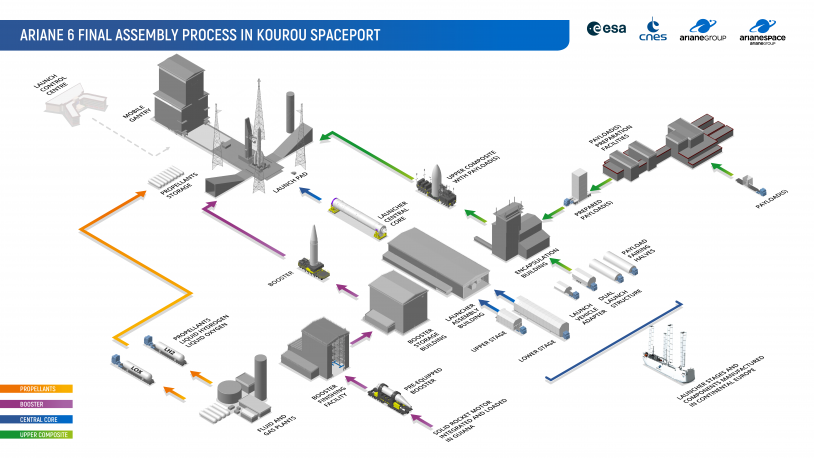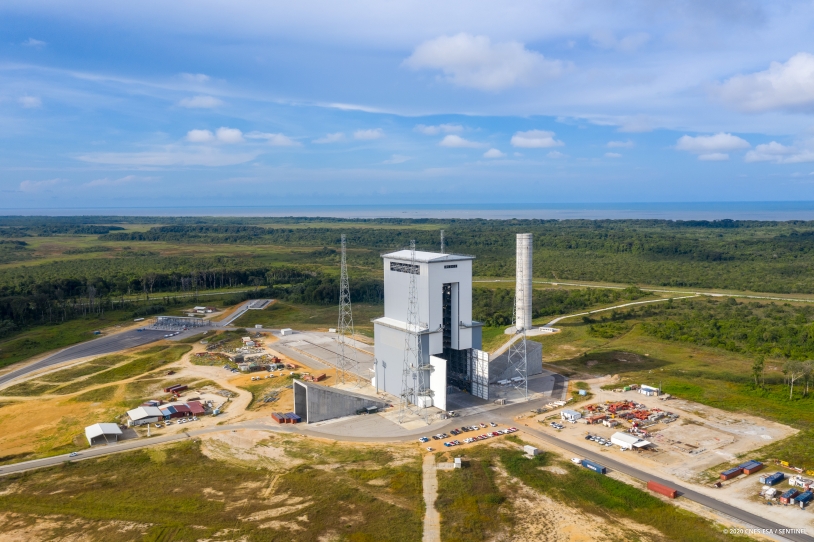Ariane 6

Ariane 6, the immediate future of European space launchers, will soon soar into space from the Guiana Space Centre. Developed to be a heavy or medium launcher depending on the needs of its mission, Ariane 6 will be available in two versions. The lighter and less expensive A62 version will be able to put satellites weighing up to 4,500 kg into geostationary orbit. The more powerful 64 version will be capable of carrying up to 12,000 kg.
With its modular design, the new launcher can be adapted to all target orbits, and therefore to all possible missions for satellites, whether for Earth observation, telecommunications, scientific experiments or navigation.
Ariane 6 is a project led by the European Space Agency, working with more than 600 companies across 13 countries. The prime contractor for the launcher is ArianeGroup. CNES is in charge of the design and construction of the launch facilities at the GSC, and Arianespace will be responsible for operating the launcher.
technical specifications
Launcher specifications
Depending on the size of its fairing (14 or 20 metres), Ariane 6 can reach up to 62 metres (compared to 58 metres for Ariane 5). Ariane 6 will have a mass of 530 tonnes in the A62 version, and 860 tonnes in the A64 version. Both versions will be composed of four separate stages.

Exploded view of Ariane 6: on the left, the Ariane 62 version, and on the right, the Ariane 64 version.
1. Solid rocket boosters
Depending on the launcher version, there are two or four solid rocket boosters (also called ESR for Equipped Solid Rocket), which provide most of the thrust at lift-off. Identical to Vega C’s first stage, they will contain 142 tonnes of solid propellant. For the first 130 seconds after lift-off, it will deliver about 350 tonnes of thrust before separating from the launcher.
2. Cryogenic lower stage
Unlike the boosters, the cryogenic lower stage (called LLPM for Lower Liquid Propulsion Module) uses liquid propulsion: it contains propellant, hydrogen and oxygen tanks. These tanks are made of insulating materials, as the two compounds are kept in liquid state at extremely cold temperatures: -182 °C for oxygen and -253 °C for hydrogen. The Vulcain 2.1 engine, located at the base of Ariane 6, uses these compounds for propulsion during the first 10 minutes of the launch.
3. Cryogenic upper stage
Like the cryogenic lower stage, the upper stage (called ULPM for Upper Liquid Propulsion Module) is powered by liquid oxygen and hydrogen. Its tanks contain 30 tonnes of it, used by the Vinci engine. The Vinci engine is an improvement over Ariane 5's HM-7B engine, and is almost three times more powerful, but also re-ignitable. With this feature, it can adjust its trajectory to reach the target orbit more easily, but also deorbit the stage once the mission is complete, and thus avoid generating debris in orbit.
4. Upper composite
The upper composite comprises the Ariane 6 fairing and the satellite(s) it contains. The 14 to 20-metre high fairing protects the satellites from aerodynamic, thermal and acoustic disturbances. Composed of two half-shells, it will open out to separate from the launcher once it is out of the atmosphere. With the Sylda, a component already used for Ariane 5, Ariane 6 will be able to put two large satellites into orbit in a single launch. Thanks to innovative systems, Ariane 6 will also be able to place constellations of satellites into orbit.
launch facilities
The new European launcher Ariane 6 has its own launch facilities, the ELA 4 (for Ariane launch complex No. 4). The 150-hectare site is located 4 km north-west of Ariane 5’s ELA 3.
The Ariane 6 launch complex includes the components necessary to prepare the launcher and its launch zone, as well as the technical buildings and liquid oxygen and hydrogen storage areas required for lift-off.
The 9th launch complex to be built at the GSC, the Ariane 6 launch pad benefits from CNES’ experience in this field to optimise operations.
After an impressive construction project from 2015 to 2021, the new facilities entered the combined testing phase in January 2022, designed to test the equipment by making real Ariane 6 components work together with the ground facilities developed by CNES.


